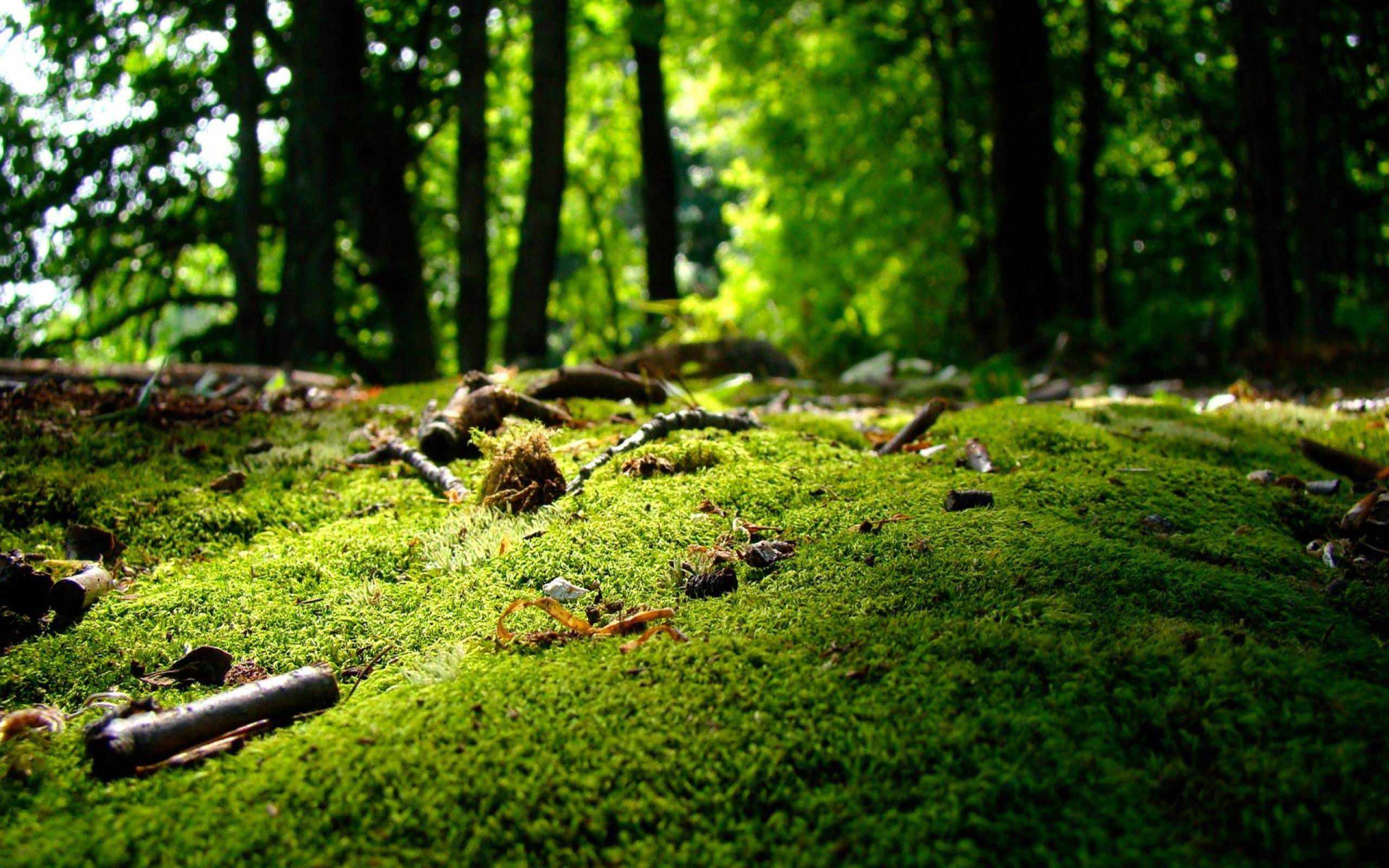Author:
Green Steps
Short summary:
Just in time for the start of the warm season, we have completed the last of 10 workshops to help schools get started with and scale place-based education. What is place-based education and why is it the only viable way out of the education and climate crisis? How can you start the project at your school? Get some answers here.

“You can recognize a really good idea by the fact that its implementation seems impossible from the outset” [Bernd Gerken, german ecologist]
Green Steps is a non-profit organization that develops innovative solutions at the intersection of education, ecology and information technology. Our vision is a world without political borders, where a single human family manages natural resources within the scientifically validated areas of ecoregions. Our mission is to transform formal education systems and provide a scalable alternative to the anthropocentric worldview. We are convinced that organizing our habitats into bioregions and ecoregions is crucial for the well-being, peace and survival of humanity.
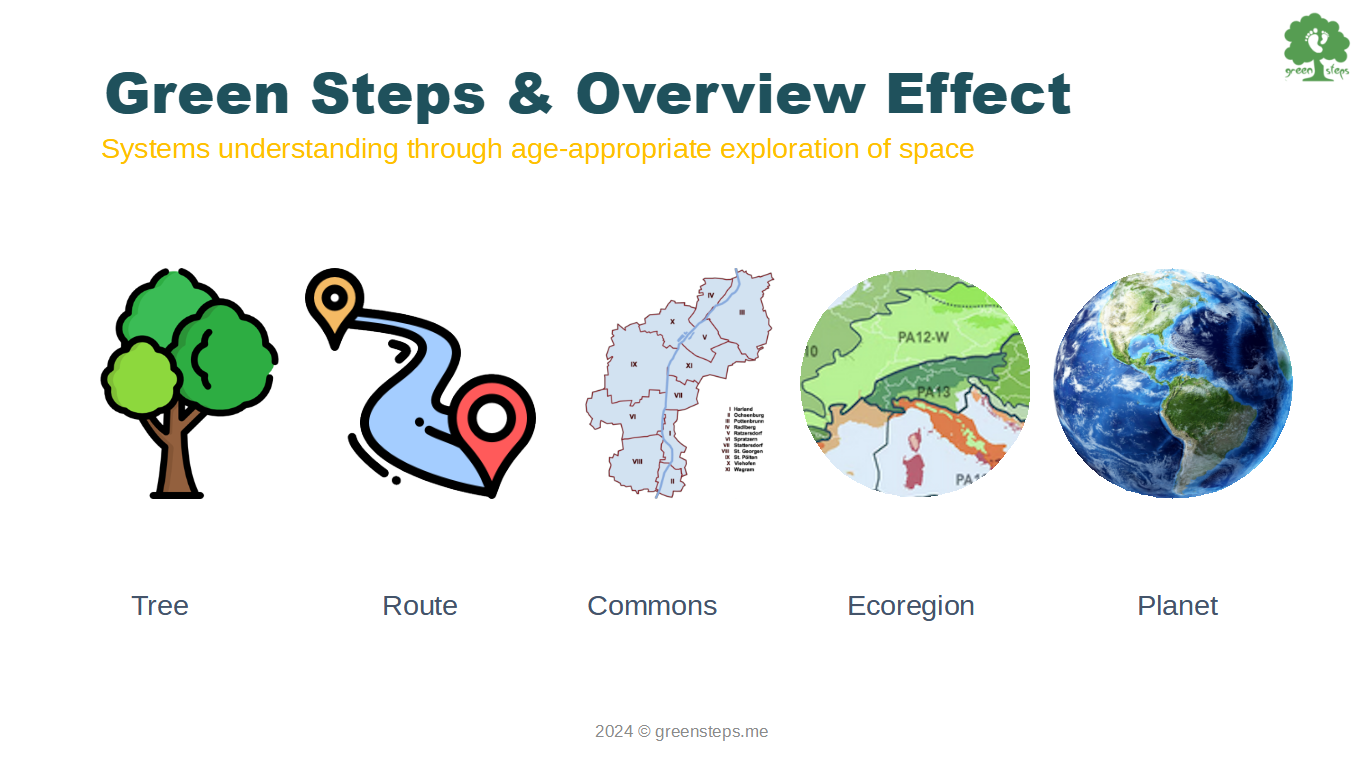
Our Big Friendly Giants game scales place-based education and seamlessly extends the school grounds to the neighborhood, community and surrounding region. It helps teachers and informal facilitators move the classroom into nature and set clear environmental learning goals. Big Friendly Giants are ancient trees and semi-permanent natural elements that guide players in age-appropriate outdoor zones to increase environmental awareness, systems understanding and community stewardship.
Players develop a bioregional identity by playfully familiarizing themselves with the plant and animal species that are typical of their local ecoregion. All game progress is recorded on the Green Steps ARK, an intuitive web app that coordinates the outdoor learning space and supports the players. The Green Steps ARK calculates the ecosystem services of trees using formulas provided by iTree and the Centre for Urban Ecology and Climate Adaptation at the Technical University of Munich, and structures the nature learning space into scientifically recognized eco- and bioregions.
*
"The childhood landscape is learned on foot, and a map is inscribed in the mind – trails and pathways and groves – the mean dog, the cranky old man’s house, the pasture with a bull in it – going out wider and farther. All of us carry within us a picture of the terrain that was learned roughly between the ages of six and nine. It could as easily be an urban neighborhood as some rural scene. You can almost totally recall the place you walked, played, biked, swam." – Gary Snyder, The Practice of the Wild
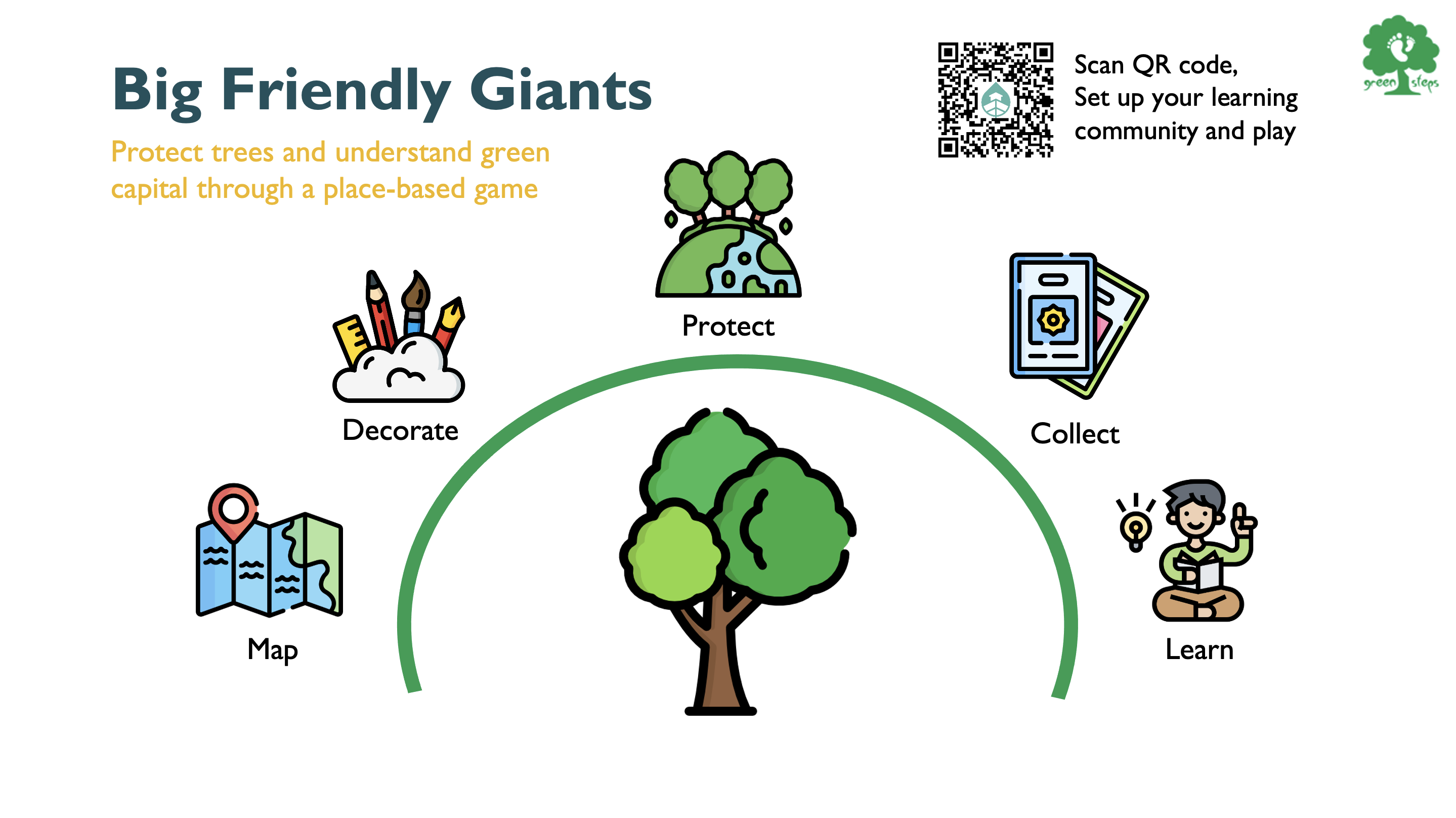
What is place-based education?
Place-based education is a method that emphasizes the authentic experience of the natural environment and sees itself as a further development of traditional environmental education. It was largely developed in the north-east of the USA, where educator David Sobel in particular made a name for himself as a pioneer of this type of learning and teaching. Put simply, place-based learning combines developmental psychology and pedagogy with space and assumes, that adolescents of different ages need different spaces to develop healthily.
Another characteristic of place-based education is that it perceives the school environment or the ecosystem in which the school is embedded as a learning space and recognizes the students as a resource for identifying and solving problems. In contrast to traditional curricula issued by state institutions, place-based education attempts to adapt standardized curricula to the circumstances and needs of school communities in a process known as "speciation", a term originally derived from evolutionary biology.
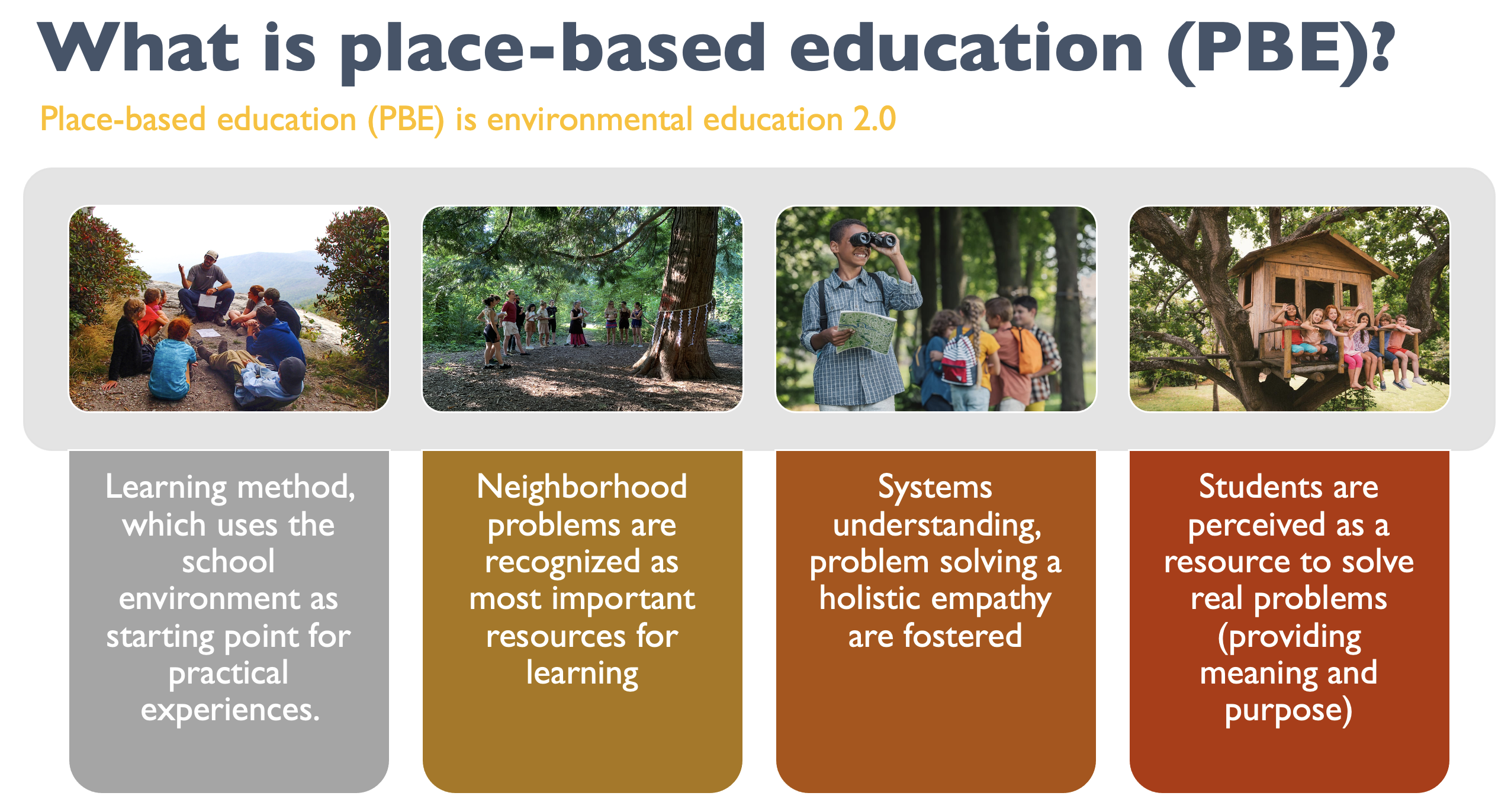
Why is place-based education rarely practiced?
The result is a high degree of school autonomy and a great deal of responsibility for school management and teachers, who can rely less on textbooks and familiar classrooms, but must act as mentors for their students to explore the near and distant school environment. It is this unfamiliar role and often unfamiliar space that deters many teachers from engaging in place-based education. A teacher who is place-based must not shy away from engaging with the school garden, the school neighborhood and beyond to the community and region.

Place-based education can take many different forms and is always interdisciplinary, which requires more coordination between teachers, at least initially. However, as soon as a project has been found to which the class or the entire school is dedicated, the coordination effort decreases in comparison to the implementation of state curricula. It is important to reach this point and embark on an experiment, which above all requires the willingness and readiness of the school management.
This acceptance of a new form of teaching often fails due to the steep hierarchies in the education administration and conservative head teachers who do not want to give up their entrenched habits for the benefit of the pupils and teachers. Individual teachers are severely hampered in the implementation of place-based education, which usually takes the form of projects, by short teaching units and can achieve little without the support of the school administration. For this reason, committed parents' associations, which campaign for the development of place-based education, are becoming increasingly important.
In education districts where place-based education is officially supported, the national and regional curriculum is reduced to principles or the specification of general learning objectives such as reading, writing or STEM. However, these learning objectives are fulfilled by school curricula tailored to bioregional conditions, which take a wide variety of approaches to achieve the learning objectives. The focus is always on a close connection between the school community and its surroundings, which makes place-based education very different from the alienating effect of national curricula, in which pupils and teachers attend school like an office building and do not know their immediate surroundings.
*
"Walking must form part of education, especially today when people do not walk, but go in vehicles, and there is a tendency towards paralysis and sloth. It is no good to cut life in two and to move limbs by sport and then move the head by reading a book. Life must be one whole, especially at an early age when the child must construct himself according to the plan and laws of development." – Maria Montessori, The Absorbent Mind
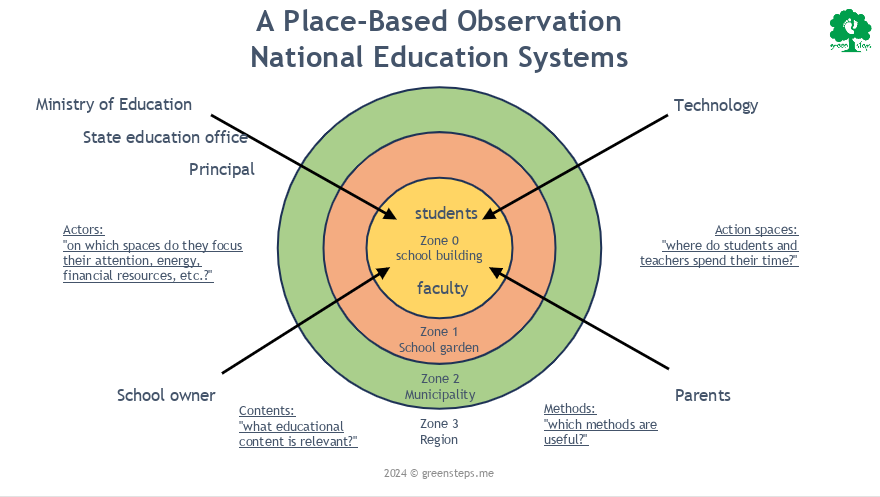
What is the impact of place-based education?
David Sobel refers to the “Roundtable on Education and the Environment”, a coalition of 16 state departments of education in the Northeast, which issued the SEER report in 1998 and published the following observations in 40 schools: Place-based education increases academic achievement in science, math, and language arts. It promotes problem-solving skills, critical thinking, and decision-making.
Particularly noteworthy in this report are the statements on enthusiasm for learning and student motivation. Students taught with place-based education were compared with national curriculum students in terms of attendance and behavior. In nine different studies, attendance was significantly higher and behavioral problems significantly lower among pupils receiving place-based education. The number of expulsions also fell accordingly.
These results are promising not only for pupils and parents, but especially for teachers, because there is no doubt that lack of attention, lack of interest and disruptive behavior have become a serious problem that can be identified as a cause of the acute shortage of teachers. However, it is not our children and young people who are to blame, but a meaning deprived system which alienates students and teachers from the resources to be found in the neighborhood.
Connecting classrooms with nature and communities seems to be a bullet proof approach to create environmental stewardship AND improve academic achievement. David Sobel refers to a report about a place-based education project in Florida, where “a significant increase in achievement in reading, writing, and math was recorded. The greatest gains in achievement, however, show up in the urban schools with large numbers of minority students from groups low on the socioeconomic scale. […] The study indicates that these findings further support the educational benefit of experiential education, especially for those student populations that are ’experience-poor’.” […]Place-based education makes a greater difference for traditionally low achieving students, thereby helping to close the achievement gap between students in poor communities and those in more prosperous ones.”
The effect of more contact with nature on physical and mental health is not mentioned by David Sobel, because for environmental educators this is a fact that has now been scientifically proven many times over. In the face of rapid urbanization and the global decline in human contact with nature, important decisions need to be made about how to preserve and enhance opportunities for experiencing nature. There is a consensus in the natural, social and health sciences about the impact of nature experiences on cognitive performance, emotional well-being and other dimensions of mental health.
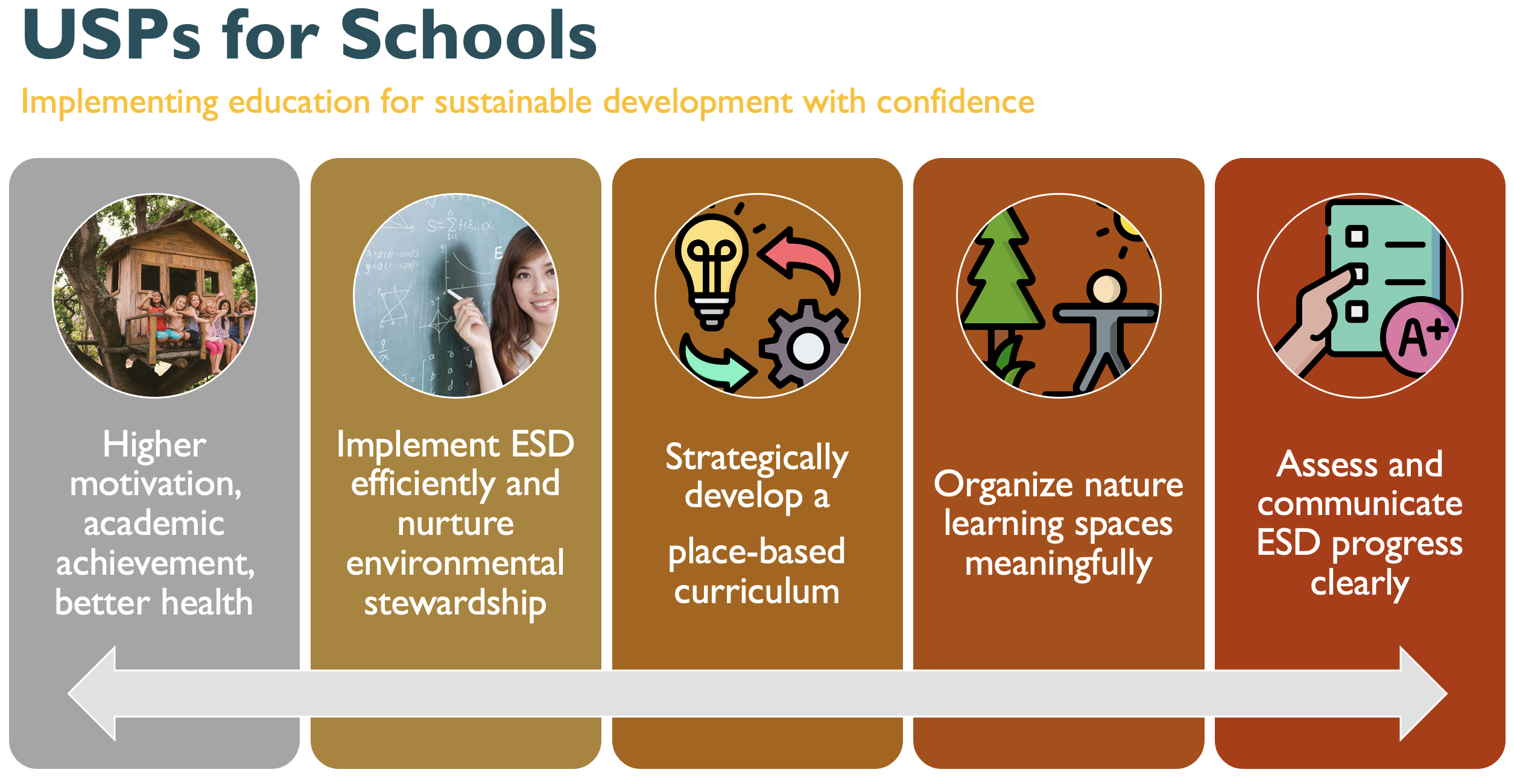
How can the status quo of place-based education be assessed?
A simple method to survey the status quo of place-based education in a school is to observe students and teachers according to the spaces they use, i.e. human geography. As part of the Big Friendly Giants environmental education project, we divided the school environment into zones, with zone 0 comprising the building, zone 1 the school garden and zone 2 the school neighborhood or community area. In most public schools, it is concluded that, on average, more than 90% of school hours are spent indoors, regardless of the age of the students.
If place-based education is seen as the only viable way to tackle the education and climate crisis, as we do, then a strategic approach is needed to overturn this ratio. The aim of parents, teachers and school leaders must be to ensure that children and young people spend a good third or more of their school hours outside Zone 0. Problems can only be identified, and solutions found by repeatedly engaging with the environment. Only by engaging with the environment - both human and non-human - can the respect and empathy be built up, that leads to greater well-being for everyone involved in society and the environment.
However, a systemic look at the Austrian education system shows that, despite nationwide programs such as Ökolog, the education administration is rigidly attached to national curricula and focuses on Zone 0 - the school building. Project-oriented and interdisciplinary learning is made difficult by this institutional framework if it is not supported by the school management. Instead of obliging school owners - if they do not recognize on their own initiative that environmental education begins at the school site - to promote place-based education with appropriate financial resources, the three-part school administration leads to a paralysis that makes conservative school principals stick to familiar patterns.
*
“As a species, we have certain conditions for learning. A kid walking down the road and around the house: what does it see? It sees small trees growing, insects and butterflies. If you see life, if you see how it grows, when you grow up, you will take care of the lives of others. It’s not school or a book. It’s the timeframe of your life, where you learn. So, when we turn our cities into places where you don’t walk, the kids don’t walk, you are raising generations, when they grow up, they won’t be human.” - Khondker Neaz Rahman, Urban Planner UNDP Bangladesh
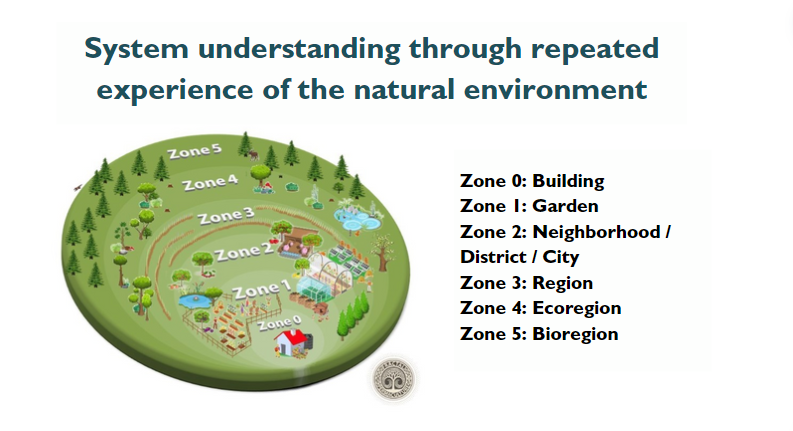
Big Friendly Giant Workshops as an aid for schools
With the Big Friendly Giant Workshops, we have created a safe stepladder for schools that want to embark on the experiment of place-based education. The workshops enable both teachers and pupils to develop a feeling for the natural space surrounding the school in manageable steps. While the first five workshops are ideally introduced by science teachers, workshops 6-10 invite teachers of a wide range of subjects to take part in an unforgettable project that will transform the school community.
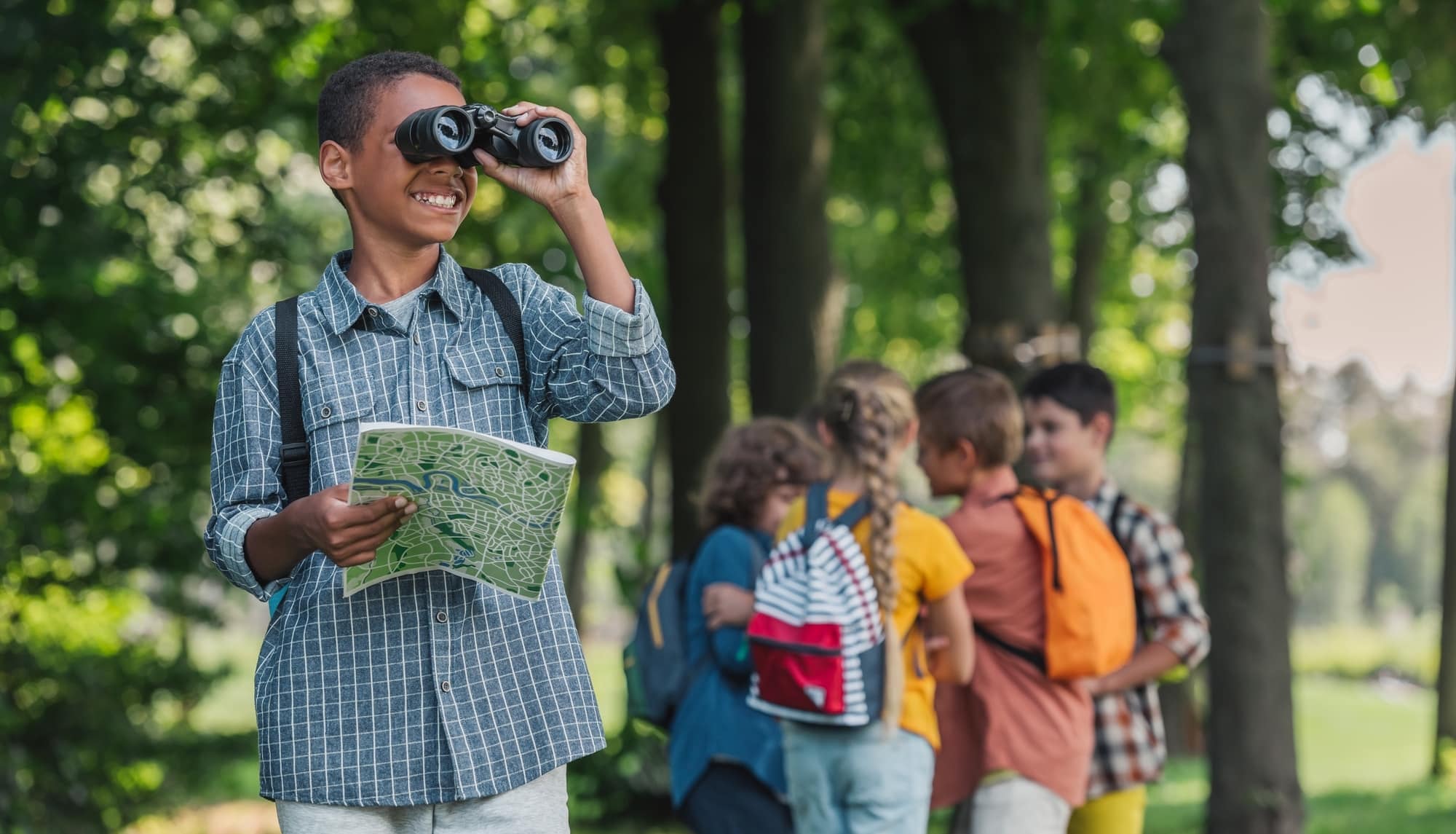
While the individual workshops follow a structure that we have created for the school year starting in the fall, it is up to each school to practice "speciation", i.e. to choose a school-autonomous implementation and, for example, to implement only one workshop. Between 75 and 120 teaching units should be scheduled for the entire project, which should ideally be roughly divided up in advance between interested teachers - there must always be room for dynamic, unforeseeable developments that arise due to the specific school context.
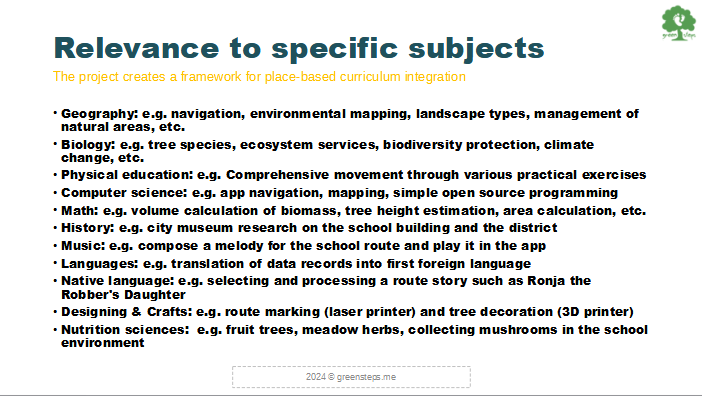
The overall aim of the project is to create one or more adventure routes starting from the school, which will be brought together in cooperation with other schools in the City National Park, where the students will guide and maintain their routes as "Urban Park Rangers aka BFG Guardians". In the course of the project, the participants achieve a number of detailed goals, which are explained in more detail in the respective workshop: https://ark.greensteps.me/library

Why is place-based education the only viable way out of the education and climate crisis?
David Sobel describes in his book "Place-Based Education: Connecting Classrooms & Communities" that the pioneers of place-based education sought methods that would improve schools and increase academic achievement. During their research, however, they realized that sustainable school improvement could not work without an equal focus on vibrant communities and healthy ecosystems. He therefore uses the metaphor of a three-legged chair for place-based education, which is composed of academic success, social capital, and an intact environment.
If you try to improve a school without involving the community, you will neither get the necessary financial support nor the human resources to successfully implement the project in question. If you focus one-sidedly on social projects but forget to involve schools, you will lack the youthful energy needed to make it work. If the focus is placed on revitalizing the economy without considering the environmental influences, the workforce in the affected community will become a scarce commodity. Employees and not least parents want an intact environment for their families.
One therefore requires the other and all three legs of this chair are united in place-based education. This indispensable link between learning success, an intact environment and vital communities becomes even clearer when considering social capital. The term "social capital" was coined by sociologist Robert Putnam to describe a person's willingness and ability to work for the collective good of a community. The more people are committed to the common good within a city or community, the higher its social capital and the healthier it is.
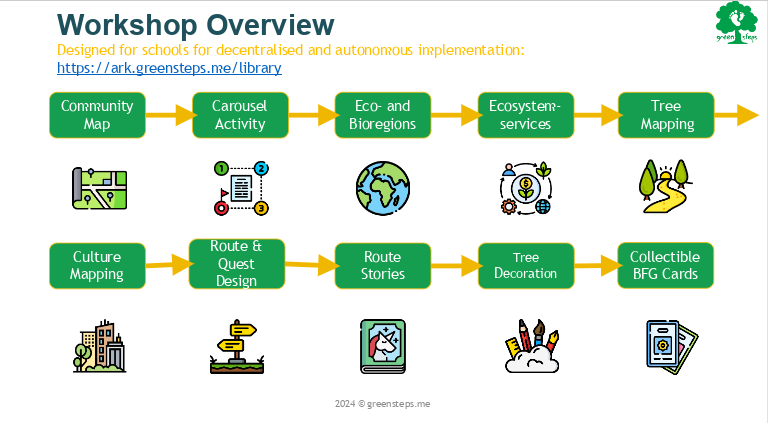
It can be observed that schoolchildren in particular show little or no willingness to work for the common good. However, this is not in their nature, quite the opposite, but is the result of a lack of local education. State-mandated curriculum deprive teachers and students of opportunities to engage with current and immediate issues in their neighborhoods - be it a community garden that strengthens a community affected by out-migration and provides the school with fresh vegetables, or the development of noise abatement measures due to a street with above-average traffic.
At this point, place-based education merges with so-called "service-learning", in which students become a central resource within a community that is used to solve upcoming problems in an efficient and economically viable way. Again, this approach to education contrasts with the reality of schools in this country, which alienate students from their immediate environment and overload them with abstract learning content.
David Sobel's research has impressively demonstrated that place-based education must find its place in the formal education system. Children who attend schools with "active" school gardens have a higher botanical knowledge and better ecological understanding than children from schools with "passive" school gardens, which are characterized by brightly mowed lawns and well-tended sports facilities. The deep integration of environmental education into the curriculum has been proven to lead to more behavioral change than the summer camp in the national park. 2-3 days of nature experience as part of the weekly timetable is key to environmental and community responsibility. (Sobel, 2013).
„Schools can be the epicenter for environmental change in their communities, motivating civic officials to take action. It’s hard, after all, to say no to your own children." – David Sobel

How can you start the project at your school?
The Big Friendly Giants environmental education format specifically counters this alienation and every teacher who gets involved in this project sits comfortably on the three-legged chair described by David Sobel, which promises academic success, increased social capital and an intact environment. So how can you start this format at your own school?
We invite interested teachers and head teachers to a one-hour preparatory Community Mentor Training, in which the individual workshops and the functions of the web-app are presented and questions are answered. We then advise on how the project can be started at the school in question and, if desired, provide support during implementation.
If you are interested, please send a short email to [email protected] with the subject "Community Mentor Training'' and the name of the school.
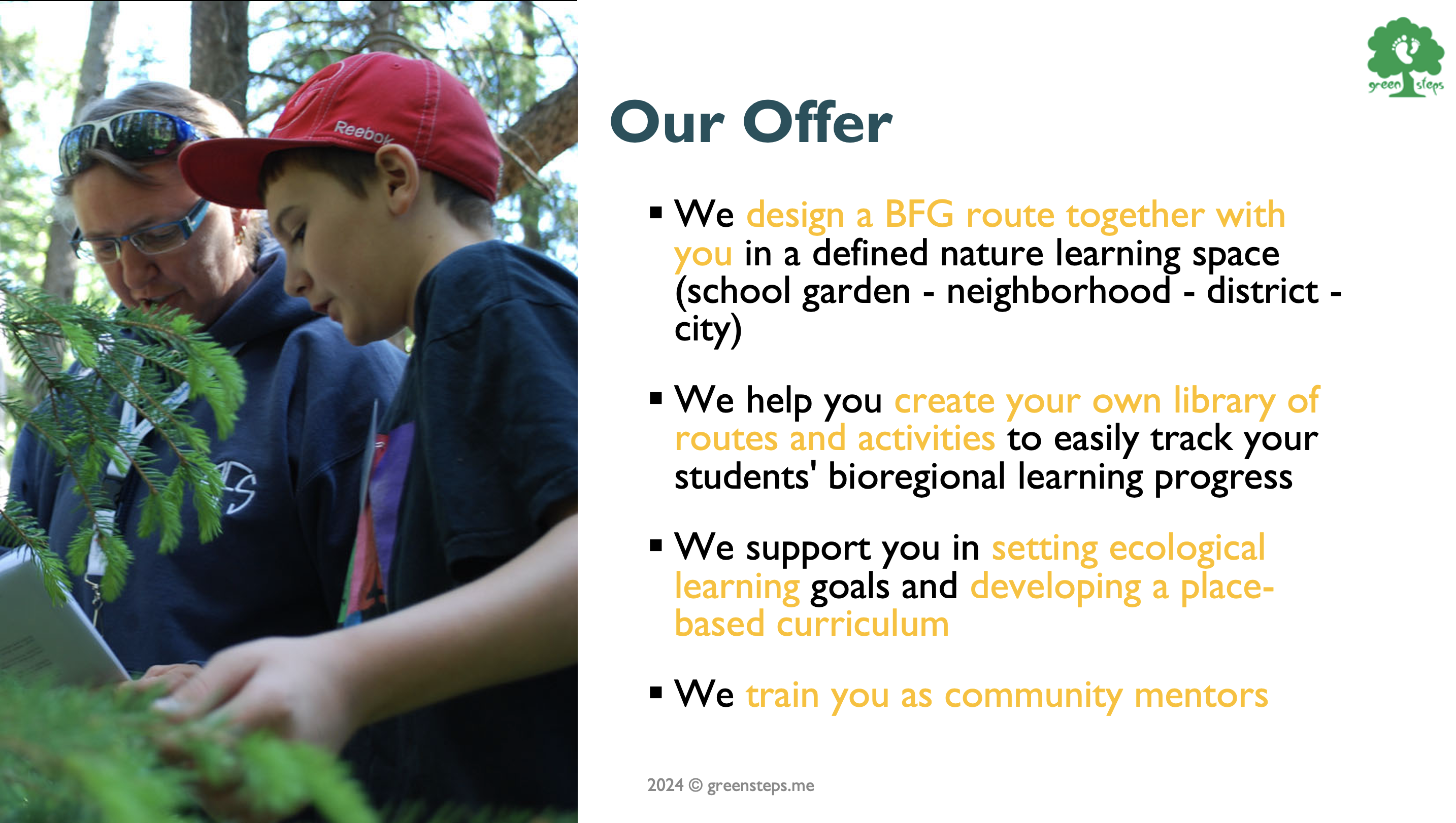
Read more
• Lillah Martien, How can gamified environmental education support municipal efforts in dealing with the climate crisis?
• Gregory N. Bratman et al., Nature and mental health: An ecosystem service perspective
• Toru Ishikawa et al., Why spatial is special in education, learning, and everyday activities
• Arne D. Ekstrom et al., Space, Time and Episodic Memory: the Hippocampus is all over the Cognitive Map
• Timothy C. Matisziw et al., The right space at the right time: The relationship between children’s physical activity and land use/land cover
• David Sobel, Place-Based Education: Connecting Classrooms and Communities
• Julie Bartsch, Community Lessons: Integrating Service Learning into K-12 Curriculum
• Erich Fromm, The Sane Society
• Jean Liedloff, The Continuum Concept: In Search of Happiness Lost
• Gary Snyder, The Practice of the Wild
• Richard Louv, Last Child in the Woods: Saving Our Children from Nature-Deficit Disorder
• Knut Wimberger, The Human Being as Ecosystem Service Provider
• Knut Wimberger, Indigenous Stewardship vs International Diplomacy
• Knut Wimberger, Education Crisis and Prisoner's Dilemma




